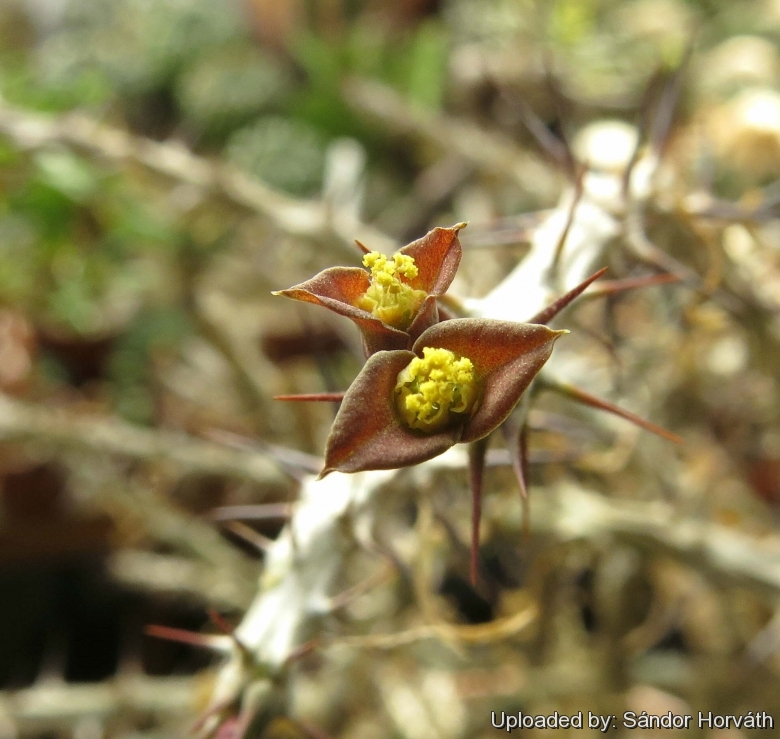




Your support is critical to our success.
Cact. Succ. J. (Los Angeles) 64(5): 265-266, f. 4-5 (1992)
Family: EUPHORBIACEAE

Origin and Habitat: Euphorbia sakarahaensisSN|32374]]SN|32374]] is endemic to the Sakaraha Forest, Sakaraha/Mahaboboka area (Toliara) in SW Madagascar; not known elsewhere.
Habitat and Ecology: This rare species grows in dry ever-green forests, under trees. Euphorbia sakarahaensisSN|32374]]SN|32374]] is threatened by habitat degradation, fire, habitat clearing for charcoal, collection for the horticultural trade.
Synonyms:
Description: Euphorbia sakarahaensisSN|23400]]SN|32374]], as is implied by the specific name, is a little-known and localised species confined to the Sakaraha forest in northern SW Madagascar. It is a deciduous caudiciform shrublet 30-50 cm tall and as wide. Low-growing with few branching spiny shoots and small yellow-green to dark brown petal-like cyathophylls (coloured bracts around the cyathia). This species is related to Euphorbia neobosseriSN|32374]]SN|23400]] but less branching, with shorter spines and variably coloured cyathophylls.
Rottstock (Caudex): The basal enlarged part oft the stem merging into a thickened taproot to form a tuberous, rounded, succulent caudex with thick, yellow-brown bark. This partially or completely subterranean, but raised in cultivation, it can grow up to 5 centimetres in diameter.
Stems: Aerial branches are of two types long and short. The long branches are slender, ascending, up to 40 cm long and 5 to 7 mm in diameter, gray-brown. The short ones are condensed branchlets produced in the leaf axils.
Leaves: Linear-lanceolate to spatulate, 20-25 mm long and a width of about 2 mm, subsessile, glabrous, dark green above and grey-green below, apex acute, base tapering. The leaves of short shoots are smaller.
Stipular spines: Solitary, spreading horizontally, slender, slightly curved, about 1 cm long, grey at the tip and light brown at the base, pubescent when young.
Inflorescences (cymes): Several at tips of branchlets, 1-to 2-forked with 2-4 erect cyathia. Peduncles sticky, 5-10 mm long, olive-brown marked red. Cyathophylls spreading, united at the base, triangular, up to 5 long and 3 mm broad, apex acuminate, the colour may vary from dull yellowish-green, to olive-brown to brown. Cyathia shortly-stalked, ball-shaped c. 2 mm in diameter, green, glabrous. Nectar-glands bright orange to cinnabar-red. Involucral bracts, shorter than glands, red. Bracteoles, yellow-green. Stamens with white filaments and orange-red anthers. Ovary globular, small, subsessile with styles basally joined, free upper parts curved back. Stigmas globular, green.
Bibliography: Major references and further lectures
1) Werner Rauh, Herman Schwartz “Succulent and xerophytic plants of Madagascar”, Volume 2 Strawberry Press, 1998
2) Original description of Euphorbia sakarahaensis by Werner Rauh in: Cactus and Succulent Journal, 64(5): 265-266, f. 4-5 (1992)
3) Haevermans, T. 2004. Euphorbia sakarahaensis. The IUCN Red List of Threatened Species 2004: e.T44441A10903984. http://dx.doi.org/10.2305/IUCN.UK.2004.RLTS.T44441A10903984.en. Downloaded on 17 January 2016.
4) Eggli, U., ed. “Illustrated handbook of succulent plants: Dicotyledons”. 2002
5) Urs Eggli, Leonard E. Newton “Etymological Dictionary of Succulent Plant Names” Springer Science & Business Media, 29 June 2013
6) Volker Buddensiek "Sukkulente Euphorbien". Ulmer, 1998
Cultivation and Propagation: Euphorbia sakarahaensisSN|32374]]SN|32374]] is a slow-growing and cold-sensitive species, it can to grow in both pots and in the ground, in areas with a mild climate, but they can even be grown indoors.
Soil: They grow well in a very draining mineral potting substrate.
Fertilization: During the summer, they enjoy average feeding and watering.
Water requirements: It should be given a winter resting period at which time less water should be given.
Hardiness: When dormant, plants are not cold-tolerants, for safe cultivation it is best to avoid temperatures below 10° C. Responds well to warmth, with its active growth period in the late spring and summer months.
Sun Exposure: Requires bright light for best appearance.
Propagation: Usually by seeds, it can also It be propagated by cuttings; if you remove an offset, remember to let it dry for a week or so, letting the wound heal (cuttings planted too soon easily rot before they can grow roots). It is better to wash the cut to remove the latex.
Warning: As with all other Euphorbias, when a plant gets damaged it exudes a thick white milky sap known as latex. This latex is poisonous and may irritate skin, so pay extreme attention not to get any in your eyes or mouth.
Cultivated plants must be handled carefully.
| Your Actions | |
|---|---|
| Back to Euphorbia index | |
| Back to Euphorbiaceae index | |
 |
Back to Succulents Encyclopedia index |
Privacy stantement - Terms and conditions - How to cite - About us - Feedback - Donate



